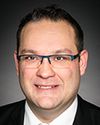Thank you, Madam Chair.
I want to thank PROC for the work that it's doing on this. It's an important piece of the boundary redistribution puzzle, so thank you for your work here.
I also want to thank the Saskatchewan commission. They did a lot of hard work, and I just want to make sure they get a shout-out for everything they've done.
It's quite normal for a Winnipegger to have an opinion about the Saskatchewan Roughriders and possibly even tell us everything that's wrong with our team, but I really was quite surprised to find someone from nine hours away who thought they knew best how to organize our riding boundaries.
I'm grateful for your concern for my constituents and our constituents. I have some questions for you, but first I want to clarify a couple of things.
For your benefit and for all of our benefit, I want to talk about the process for a minute.
Mr. Blaikie, you mentioned in your letter a lengthy public consultation process that occurred before the first report was done. I want to clarify that, because it's actually not true. Before the first report was done, it was really just special interest groups and insiders who knew about the process who were able to submit before that first report was done. I was one of them. We submitted as MPs, so we knew about the process, but I would not call that consultation.
Of course, the commission in Saskatchewan was faced with a big problem. The population of Regina and Saskatoon had grown quite significantly compared to the rural area of the city, so the first proposal did include a major redrawing of the Saskatchewan map. Every riding was affected, some in a very big way. Saskatoon was significantly changed. Changing Saskatoon actually caused every other riding in the province to be affected because of our large rural ridings that are so interconnected and intertwined.
At this point came the very lengthy public consultation process that you mentioned, so that was after the first report. It was very well done. There were 15 meetings that were vigorously advertised. They were all across the province. They were very well attended, with a wide variety of witnesses.
I want to point out that in Saskatoon, there were 24 presentations, I believe.
Four of them were in favour of Saskatoon centre, as you indicated. One was from a former provincial NDP candidate. One was from some NDP EDA president. One was from an NDP nomination candidate. The fourth one was from the NDP candidate who ran against me in the last election. There's a bit of theme there, if you can tell.
The other 20 presentations made in Saskatoon argued against Saskatoon centre, and they came from a wide variety of people: a community association president; members of the immigrant communities; business leaders; community and downtown development organizations; the chief of the Saskatoon Tribal Council, who represents seven local first nations; religious leaders; MPs and others. I'll briefly explain a bit of their logic.
First, based on all the information received, a major redo of the map was undertaken by the commission. Again, every riding was touched. It mostly reverted back to the initial starting point, actually, but it took a lot of work to get there because of the changing population bases.
The process was lengthy and detailed, as you said, but the result was an overwhelming rejection of Saskatoon centre and all the domino effects required to make that happen.
Finally, Mr. Blaikie, I don't believe you were part of the lengthy consultation process in Saskatchewan, so I would like to provide some insights—again, for all of us here—into why the commission decided the way it did.
I don't presume to know why they did what they did. I wasn't a part of the commission, obviously, but I was intimately involved in the hearings, and I understand Saskatchewan intimately. I've lived there my whole life.
The first area I believe they looked at was community of interest, so I'm glad you mentioned that in your opening remarks. People from Manitoba and outside Saskatoon probably don't understand. I don't know if you have a copy of this map. There is one that I've given to the clerks to hand out, if they wouldn't mind doing that. It's very simple to see how Saskatoon is divided by the river down the middle. It creates an east side and a west side. That's a real, major label that people use to describe themselves—you're either from the east side or the west side. It's completely ingrained into our identity in Saskatoon.
The river, right down the middle as you can see, is a natural barrier. It restricts travel, except for major artery roads and highways. It's also a major social, economic and demographic barrier, with significantly different histories on either side. That is why, in 2012, the commission, when faced with the same question, rejected the idea of crossing the river. It didn't match the way the city was.
The other strange thing about this, when you look at this map, is that it allowed.... What was left over was part of the riding. It went together with this part down in the south, and it went together with this part in the east, a very strange collection of leftover bits and pieces caused.... It was one of the effects of having the centre riding, so a very strange thing.
The second area they considered was the testimony from the tribal chief, Mark Arcand, and others. He said that the majority of Indian and Métis people live on the west side of the river.
They presented census data that proved that point. He said that Saskatoon centre would dilute indigenous representation, as the indigenous population is mostly on the west side. I'll paraphrase what he said: Most people who live on the east side haven't spent time on the west side, so how can they speak for indigenous people? The boundary that they've proposed cuts right through the centre of that indigenous population.
Finally, I believe they looked at the at-risk population, which, again, is centred on the west side of the city. It has services for that population on both sides of the boundary that was proposed, so it really didn't make sense.
I hope that helps everybody understand a bit better the process that happened in Saskatoon.
How much time do I have left, Madam Chair?






